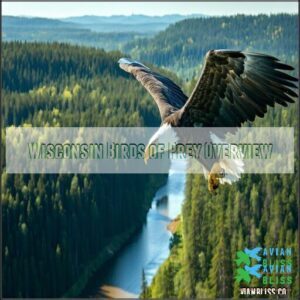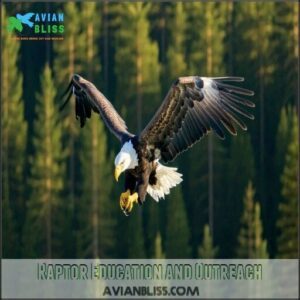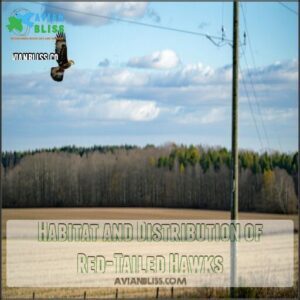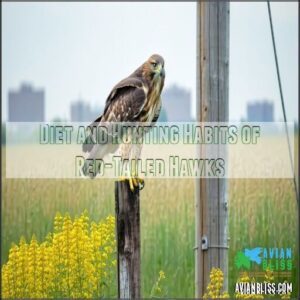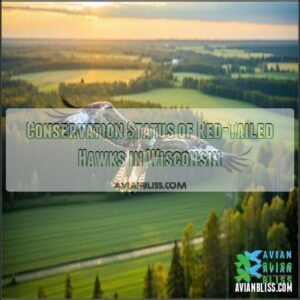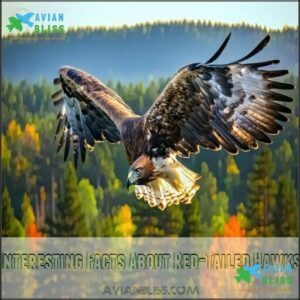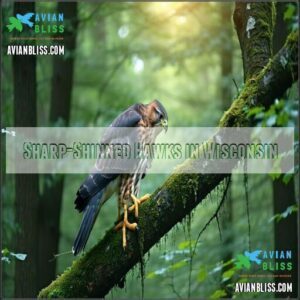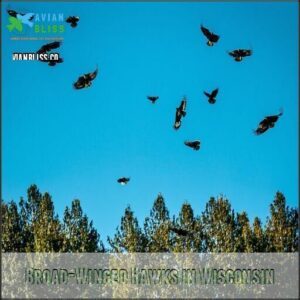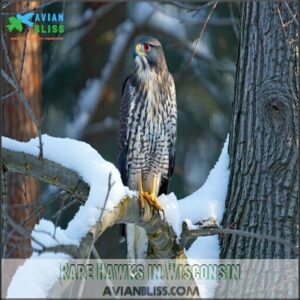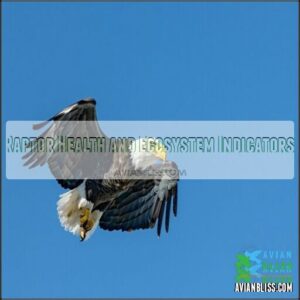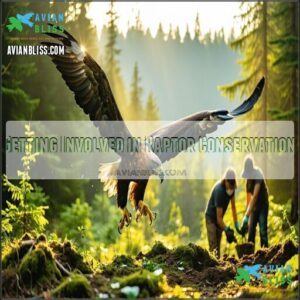This site is supported by our readers. We may earn a commission, at no cost to you, if you purchase through links.
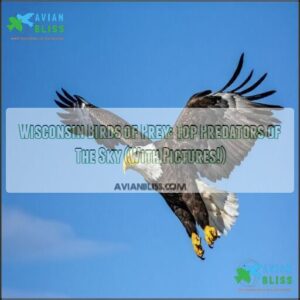
These sharp-eyed hunters have powerful beaks and talons that help them catch mice, rabbits, and fish. The bald eagle and osprey prefer areas near lakes, while red-tailed hawks patrol open fields from tall perches.
Many of these raptors faced population declines but have bounced back thanks to conservation efforts. You can spot these magnificent birds year-round, though migration seasons offer the best viewing opportunities.
Their silhouettes against the sky tell a story of survival and adaptation that’s been unfolding in our state for centuries.
Table Of Contents
- Key Takeaways
- Wisconsin Birds of Prey Overview
- Raptor Education and Outreach
- Red-Tailed Hawks in Wisconsin
- Other Common Hawks in Wisconsin
- Rare Hawks in Wisconsin
- Where to Find Hawks in Wisconsin
- Raptor Health and Ecosystem Indicators
- Threats to Raptors in Wisconsin
- Getting Involved in Raptor Conservation
- Frequently Asked Questions (FAQs)
- Did I see a hawk or a falcon?
- What are the top 5 birds of prey?
- What bird is mistaken for a hawk?
- What raptors live in Wisconsin?
- What is the largest hawk in Wisconsin?
- What is the biggest bird in Wisconsin?
- What is the big bird of prey in Wisconsin?
- What is the biggest hawk in Wisconsin?
- Does Wisconsin have peregrine falcons?
- What kind of eagles live in Wisconsin?
- Conclusion
Key Takeaways
- You’ll find about 15 species of birds of prey in Wisconsin, including eagles, hawks, falcons, and owls, with the Red-tailed Hawk being the most common and the Bald Eagle thriving near lakes and rivers.
- Wisconsin’s raptors serve as important ecosystem indicators—their presence signals a healthy environment as they control prey populations, remove sick animals, and maintain ecological balance.
- Many of Wisconsin’s birds of prey have recovered from population declines thanks to conservation efforts, though some species like the Peregrine Falcon and Red-shouldered Hawk still face challenges from habitat loss and contamination.
- You can support raptor conservation through volunteering with rehabilitation programs, participating in citizen science projects, donating to conservation organizations, or simply spreading awareness about these magnificent predators.
Wisconsin Birds of Prey Overview
Wisconsin is home to a fascinating variety of birds of prey, from hawks and owls to eagles and falcons.
These skilled hunters thrive in the state’s forests, wetlands, and grasslands, playing a pivotal role in the ecosystem.
Types of Birds of Prey in Wisconsin
Wisconsin is home to a dazzling array of raptors, or birds of prey, showcasing their sky-high mastery. From agile hunters to majestic giants, these predators bring a wild charm to the state.
Here’s a glimpse of some awe-inspiring Wisconsin raptors:
- Red-tailed Hawks: With their unmistakable rusty tails, they’re often spotted soaring over fields, scanning for small mammals. They’re the most common hawk species in Wisconsin.
- Bald Eagles: Majestic symbols of freedom, they’re thriving. Look for eagle sightings near lakes and rivers.
- Cooper’s Hawks: These stealthy hunters zip through forests, expertly targeting songbirds.
- Peregrine Falcons: Known for speed, these falcons hit over 200 mph in hunting dives—a spectacular display of skill.
Exploring Wisconsin birds of prey reveals their incredible adaptations and their essential role in ecosystems.
Habitat and Distribution of Birds of Prey
Raptors thrive across diverse Wisconsin bird habitats, from dense forests to expansive wetlands.
Urban habitats also play a role, with some adapting to city life.
Forest fragmentation and prey abundance impact their nesting and migration routes.
Climate impacts add another layer, influencing species spread.
These striking Wisconsin birds of prey reveal fascinating shifts in distribution driven by environments, migration, and adaptability.
Diet and Hunting Habits of Birds of Prey
Watching Wisconsin’s avian predators hunt is mesmerizing.
Sharp-shinned hawks ambush, targeting songbirds mid-air. Cooper’s hawks master high-speed surprises, often near bird feeders. Red-tailed hawks rely on perched scouting, spotting movement below.
Their raptor diet in Wisconsin includes rodents, birds, and insects—vital links in food webs.
Seasonal diet changes highlight adaptability and how their hunting techniques shape local ecosystems, ensuring balance.
Conservation Status of Birds of Prey in Wisconsin
In the context of balancing raptor populations, Wisconsin faces tricky challenges.
While eagle populations thrive, some species, like the Peregrine Falcon, remain on the list of endangered raptors in Wisconsin.
Habitat protection, public awareness, and legal protections play essential roles in their survival.
Climate impacts and habitat loss can disrupt population trends, stressing the need for Wisconsin conservation efforts.
Join raptor conservation projects to protect these majestic hunters and bolster Wisconsin’s ecosystem balance.
Raptor Education and Outreach
You’ll find that educating people about Wisconsin’s incredible raptors plays a big role in protecting these essential birds.
From school programs to wildlife rehabilitation, outreach efforts help communities understand why these predators are so important.
Educational Programs for Schools and Communities
Learn about Wisconsin’s wildlife through inspiring programs like Hoo’s Woods! These include:
- Interactive school programs teaching raptor ecology.
- Community workshops on bird conservation in Wisconsin.
- Live demonstrations featuring raptor ambassadors.
- Hands-on activities with citizen science projects.
These enriching experiences connect you with Wisconsin avian predators while supporting raptor rehabilitation. Whether you’re into Wisconsin bird watching or conservation education, these programs spark curiosity and a love for nature.
Raptor Conservation Efforts in Wisconsin
In Wisconsin, raptor conservation thrives through a mix of community engagement, legislative support, and innovative programs.
Organizations tackle habitat preservation, restore 12,590+ acres, and use research monitoring to track progress.
Efforts like lead-free hunting reduce disease and pollution impacts on threatened and endangered raptors.
Programs such as citizen science unite locals with bird conservation efforts.
These bird conservation efforts in Wisconsin save species while inspiring action, and by joining local initiatives, you can help protect Wisconsin’s remarkable raptors and support future generations of aerial predators!
Raptor Rehabilitation and Release Programs
Helping injured raptors regain their freedom is no small feat in Wisconsin.
Wildlife rehab centers, like Hoo’s Woods, focus on raptor rehabilitation with care and precision.
Here’s what they do:
- Create treatment plans customized to each bird.
- Provide flight training in specially-designed enclosures.
- Monitor released raptors to track survival rates.
These rehab programs guarantee ethical standards while improving release success rates. Donations and volunteers make these conservation efforts possible.
Community Engagement and Outreach Initiatives
Raptors connect us all with their majestic flight and sharp instincts.
Explore Wisconsin’s bird conservation community through exciting opportunities like:
- Volunteer opportunities with raptor rehabilitation programs.
- Educational workshops that teach about raptor behavior and ecosystem roles.
- Citizen science projects where you’ll track migration or nesting patterns.
- Conservation partnerships with organizations championing raptor conservation in Wisconsin.
These community engagements inspire public awareness while fostering bird conservation education.
Join the bird-watching community to make a real difference—you’ll learn and contribute!
Red-Tailed Hawks in Wisconsin
You’ll often spot Red-Tailed Hawks soaring high above Wisconsin’s open fields and forests, their iconic red tails catching the sunlight.
These adaptable hunters thrive in a variety of habitats, using keen eyesight to search for prey like small mammals, birds, and reptiles.
Habitat and Distribution of Red-Tailed Hawks
Red-tailed Hawks are true masters of adaptability, thriving across Wisconsin’s diverse habitats.
You’ll spot them soaring gracefully over farmland, their rust-colored tails glowing in the sun.
These raptors have an eye for opportunity:
- Open fields and prairies, where prey like rodents is abundant.
- Perched on utility poles, scanning the landscape with precision.
- Nestled near forests’ edges, balancing shelter and visibility.
From wetlands to grasslands, they occupy prime territory.
Southern Wisconsin sees the highest numbers, thanks to habitat variation and prey abundance.
These hawks adapt well to human impact and fluctuating climates, securing their presence statewide.
Diet and Hunting Habits of Red-Tailed Hawks
You’ll often see Red-tailed Hawks demonstrating sharp Prey Selection and efficient Hunting Techniques, snatching up voles and rabbits with ease.
Their Seasonal Diet adapts to the prey available, showcasing their resourcefulness.
Whether cruising open fields or perched along woodlands, these avian predators keep the balance.
Their skillful talons and sharp vision make them true stars among hawk species Wisconsin thrives on.
They’re known to use urban telephone poles as hunting perches.
Conservation Status of Red-Tailed Hawks in Wisconsin
The conservation status of Red-tailed Hawks in Wisconsin remains strong, with stable population trends throughout the state.
Unlike some threatened raptors in Wisconsin, these resilient birds have adapted well to changing landscapes.
Key factors supporting their success include:
- Robust habitat protection initiatives by local conservation groups
- Reduced pesticide use improving breeding outcomes
- Strategic nest site management in both rural and urban areas
Bird conservation efforts continue to monitor these magnificent predators to guarantee their continued prosperity.
Interesting Facts About Red-Tailed Hawks
Beyond their iconic red tails, these adaptable raptors possess vision eight times sharper than yours.
Red-tailed hawks can dive at speeds up to 120 mph with an impressive 85% hunting success rate. They’re masters of Wisconsin ecosystems, with nesting habits that showcase remarkable engineering skills.
Their distinctive vocalizations—often used in movie soundtracks—are instantly recognizable. Color variations exist across different regions, making each hawk uniquely beautiful.
Other Common Hawks in Wisconsin
You’ll spot several hawk species in Wisconsin beyond the familiar red-tailed hawk, including the agile Cooper’s hawk that hunts songbirds and the compact sharp-shinned hawk that zips through forests.
Wisconsin’s diverse landscapes support seasonal visitors too, like the broad-winged hawk that soars on summer thermals and the rough-legged hawk that arrives when winter pushes it south from Arctic breeding grounds.
Cooper’s Hawks in Wisconsin
While Red-tailed Hawks command the open skies, Cooper’s Hawks rule Wisconsin’s forests with remarkable agility. These medium-sized raptors have mastered canopy hunting, weaving through dense tree branches at high speeds.
You’ll recognize Cooper’s Hawks by their slate-gray backs, rufous-barred chests, and distinctive squared-off tails. They’ve become accomplished urban adapters, bringing their hunting skills right to Wisconsin backyards.
When observing these Wisconsin wildlife masters, note their:
- Incredible songbird predation techniques, often ambushing feeders with calculated precision
- Nesting behavior in tall trees where they construct platform nests of sticks and bark
- Year-round presence in many Wisconsin neighborhoods, unlike migratory cousins
- Distinctive flight pattern with several quick wingbeats followed by gliding
Their blue-gray plumage and reddish-orange eyes make birds of prey identification straightforward once you know what to look for. Listen for their "kek-kek-kek" calls echoing through the woods.
Sharp-Shinned Hawks in Wisconsin
The smallest hawk in Wisconsin, Sharp-shinned Hawks are forest specialists with impressive hunting skills.
You’ll find these compact predators darting through dense woodlands with remarkable agility.
| Feature | Details |
|---|---|
| Size | 9-13.5 inches |
| Wingspan | 16.5-26.5 inches |
| Hunting Style | Ambush |
Their slate-blue backs and rusty barred chests make Sharp-shinned ID easier during backyard encounters, where they often target smaller birds.
Broad-Winged Hawks in Wisconsin
Spotting Broad-Winged Hawks in Wisconsin can be a highlight of your bird watching adventures. These forest-dependent raptors migrate through the state in impressive kettle formations each spring and fall.
Their migration routes extend from Canada to Brazil, showcasing their incredible journey, which can be found in more detail at Their migration routes.
Some key characteristics of Broad-Winged Hawks include:
- Their compact bodies and short, broad wings help them maneuver through dense forest canopies
- Listen for their distinctive piercing whistle – a single "kee-eee" that echoes through Wisconsin woodlands
- Look for their chunky silhouette and distinctive white tail bands when perched
- They’re most visible during September migration when thousands form spectacular kettles.
Unlike other Wisconsin bird species, these hawks prefer mature forests and face conservation challenges from habitat fragmentation. Visit central Wisconsin bird watching locations during migration season for your best chance at seeing them, which is a truly incredible journey and a highlight of bird watching adventures.
Rough-Legged Hawks in Wisconsin
Wisconsin’s Rough-legged Hawks grace our winter grasslands from November through March.
You’ll spot these winter migrants hovering like kites while hunting small mammals.
Their distinctive plumage variations include light and dark morphs.
Also called Rough-legged Buzzards, these raptors are key to any Wisconsin birdwatching expedition, and their behavior includes hovering while hunting.
Rare Hawks in Wisconsin
You’ll find several hard-to-spot hawks in Wisconsin that make any birdwatching trip feel like winning the nature lottery.
These elusive birds include the Northern Goshawk with its secretive forest habits, the Red-shouldered Hawk known for its rich reddish underparts, and the occasional Swainson’s Hawk that might surprise you during migration seasons.
Swainson’s Hawks in Wisconsin
While some hawks are common in Wisconsin’s skies, Swainson’s Hawks present a special challenge for bird enthusiasts.
These elegant raptors are a true Wisconsin birdwatching prize due to their scarcity in the state. You’ll need sharp identification tips to spot their distinctive light-colored bellies and dark flight feathers.
Here’s why these hawks deserve your attention:
- They travel an astounding 12,000-mile migration route to Argentina annually
- Their habitat preferences include open grasslands and agricultural areas
- Their conservation status remains vulnerable due to pesticide exposure
- Their rarity explained: Wisconsin sits at the eastern edge of their range
Ferruginous Hawks in Wisconsin
A needle in the haystack describes the Ferruginous Hawk’s status in Wisconsin ecosystems, with conservation efforts recently showing positive results.
As North America’s largest hawk species, their hypothetical presence excites birders seeking rare raptors.
| Feature | Conservation Status | Identification Tips |
|---|---|---|
| Size | Population under 4,000 pairs | Largest buteo in North America |
| Habitat | Grasslands with preservation needs | Open, arid areas are key |
| Trends | Increasing in some regions despite habitat loss | Public awareness growing |
You’ll face significant identification challenges when searching for these hawks in Wisconsin due to their habitat suitability issues. Bird conservation Wisconsin initiatives include habitat preservation and research programs supporting these majestic predators.
The Ferruginous Hawk remains an elusive visitor to Wisconsin’s landscapes, representing one of our rarest raptor sightings. As North America’s largest hawk species, these impressive birds are mostly hypothetical in our state but benefit from broader conservation initiatives. The state is also home to the red-tailed hawk, a much more common species.
| Feature | Conservation Status | Identification Tips |
|---|---|---|
| Size | Population under 4,000 pairs | Largest buteo in North America |
| Habitat | Grasslands with preservation needs | Open, arid areas are key |
| Trends | Increasing in some regions | Look for rusty shoulders and legs |
You’ll face significant identification challenges when searching for these hawks in Wisconsin due to their habitat suitability issues. Bird conservation Wisconsin initiatives include habitat preservation and research programs supporting these magnificent predators, though they primarily benefit from public awareness campaigns in their core western range.
Northern Goshawks in Wisconsin
The "ninjas" of Wisconsin’s raptors, Northern Goshawks blend stealth with deadly precision in the state’s deep forests.
These rare, secretive hawks are distinguished by their slate-gray backs, light gray undersides, and distinctive white eyebrow stripes.
You’ll find these powerful birds in mature woodlands, where they build nests in the largest trees.
Their secretive nature and swift hunting skills make spotting one a special treat for birdwatchers.
Listen for their sharp "kik-kik-kik" calls while exploring Wisconsin’s dense forest canopies.
Red-Shouldered Hawks in Wisconsin
Unlike the secretive Northern Goshawk, the Red-shouldered Hawk faces serious conservation challenges in Wisconsin.
Placed on the state’s threatened species list in 1979, these striking raptors continue to experience population declines according to Breeding Bird Survey data.
The Red-shouldered Hawk’s identification guide starts with their distinctive reddish "shoulders" and habitat preference for mature forests near wetlands.
Their clear, whistling vocalizations can help you locate them when visual spotting proves difficult.
They’re known to employ a perch-hunting strategy to find prey.
- Your heart might sink knowing most of their Wisconsin habitat was altered by logging and hasn’t recovered
- You’ll feel awe watching their graceful flight patterns against morning skies
- Your concern grows learning they’re threatened in 13 states including Wisconsin
- You’ll feel hope seeing conservation efforts focused on specific ecological landscapes
- Your curiosity peaks observing juvenile hawks, which lack the adult’s distinctive markings
Habitat fragmentation often results in Red-tailed Hawks replacing these elegant predators.
Where to Find Hawks in Wisconsin
You’ll find Wisconsin’s hawks in diverse habitats from Horicon Marsh’s open wetlands to the forested areas of Devil’s Lake State Park where they soar overhead hunting for prey.
Wisconsin’s location along major migration routes means you can spot these magnificent birds year-round, with peak viewing during spring and fall migrations when they gather in impressive numbers, making it an ideal time to see them in large numbers.
Best Places to Spot Hawks in Wisconsin
I’ll create improved content for this section about hawk viewing locations in Wisconsin.
Birdwatchers flock to Wisconsin’s diverse landscapes for incredible hawk viewing opportunities. The state offers prime habitat variety where you can observe these magnificent raptors in their natural environment.
Wisconsin’s public lands provide excellent hawk-watching locations throughout the year. Here are three migration hotspots that shouldn’t be missed:
- Horicon Marsh Wildlife Area: This expansive wetland complex attracts numerous hawks and other birds of prey. The observation deck offers panoramic views where you might spot a Red-tailed Hawk soaring overhead.
- Wyalusing State Park: Perched at the confluence of the Wisconsin and Mississippi Rivers, this park’s high bluffs create perfect thermal updrafts for hawks during seasonal changes.
- Devil’s Lake State Park: The quartzite bluffs provide essential nesting areas for several hawk species, including Cooper’s Hawks and Sharp-shinned Hawks.
Remember to bring binoculars and a Wisconsin bird guide to help identify these magnificent raptors.
Hawk Migration Patterns in Wisconsin
If you’ve enjoyed spotting hawks at Wisconsin’s prime locations, you’ll be amazed by their migration spectacles. Hawks follow distinct flyways across the state during their biannual journeys.
Wisconsin’s raptors showcase a fascinating migration timeline. From mid-August through December, hawks travel in waves – juveniles moving first (August-September), followed by adults dominating the November migration.
Weather impacts these journeys substantially, with southwest winds triggering Peregrine movements and thermal currents lifting Broad-winged Hawks into massive "kettles" of thousands along Lake Michigan’s shoreline.
For peak migration viewing, visit Cedar Grove Ornithological Station in Sheboygan County during September-November. You’ll witness hawks following the Lake Michigan coastline, creating one of nature’s most impressive displays.
From your favorite hawk-watching spots, you’ll witness an amazing aerial highway during migration season. Hawks travel through Wisconsin from mid-August through December, following two main patterns.
First come the juveniles (mid-August to mid-September), then adults dominate November flights. Broad-winged Hawks create spectacular displays along Lake Michigan in September, with thousands visible daily.
Hawks typically follow shorelines to avoid crossing large water bodies, with Peregrine falcons moving when southwest winds blow. Cedar Grove in Sheboygan County offers excellent opportunities to witness this raptor migration spectacle.
Hawk Nesting Sites in Wisconsin
Across Wisconsin’s varied landscapes, hawks demonstrate remarkable site fidelity when selecting their perfect nesting spots.
Research shows each species has specific preferences that increase their breeding success rates.
Wisconsin bird watching spots offer fascinating glimpses into raptor nesting habits:
- Red-tailed Hawks build bulky nests averaging 28" x 21" x 14" in tall trees or occasionally cliff faces, often near urban areas with grassland access
- Cooper’s Hawks prefer forest stands with nest heights averaging 15.1 meters, typically 59.7% up the tree
- Broad-winged Hawks select nest sites in older mesic forests, usually >1 km from neighboring nests with 79% success rates
- Red-shouldered Hawks construct nests about 17 meters high in large hardwoods within wet woodlands
- Northern Goshawks line nests with conifer sprigs, birch bark and moss, often protecting trees with metal baffles against nest predators like fishers
Nesting season runs March through July, with most species using sticks, leaves, and bark as nest materials for their carefully crafted homes. Broad-winged Hawks favor areas with mature forest habitats for nesting, which is crucial for their specific preferences and overall breeding success.
Hawk Watching Tips and Etiquette
Birders often discover that hawk watching rewards both patience and preparation.
You’ll spot more Wisconsin raptors by mastering these simple techniques:
- Bring quality binoculars and a field guide for identifying hawks from their distinctive silhouettes and flight patterns
- Respect habitats by maintaining distance from nesting sites, especially during breeding seasons when Red-tailed Hawks become territorial
- Join local birdwatching groups where experienced watchers share tips on raptor identification
Wear earth-toned clothing to blend with your surroundings. Remember, ethical birding means observing quietly without disturbing these magnificent birds of prey.
To enhance your viewing experience, consider investing in specialized hawk watching. As my grandfather used to say, "The best hawk photos happen when they don’t know you’re there.
Raptor Health and Ecosystem Indicators
You’ll notice that the health of Wisconsin’s hawks, owls, and eagles tells you a lot about our local environment.
When these top predators thrive, it’s a clear sign that the ecosystem below them is in balance.
The Role of Raptors in The Ecosystem
Soaring above Wisconsin’s landscapes, raptors serve as nature’s perfect balancing act in our local ecosystems.
You’ll find these magnificent birds playing vital roles that extend far beyond their stunning aerial displays.
| Raptor Role | Ecosystem Impact | Example Species |
|---|---|---|
| Prey control | Maintains rodent populations | Red-tailed Hawk |
| Carrion removal | Prevents disease spread | Turkey Vulture |
| Trophic cascade | Influences multiple wildlife levels | Bald Eagle |
As top predators, they prevent prey population explosions, remove sick animals, and contribute to seed dispersal through their hunting activities.
Wisconsin’s ecosystems wouldn’t function properly without these avian architects of balance, ensuring a delicate balance in the environment, and their role in prey control is crucial for the ecosystem’s health.
Environmental Factors Affecting Raptor Health
Wisconsin’s majestic raptors face mounting environmental challenges that directly impact their health and survival. When you understand these threats, you’ll better appreciate conservation efforts happening throughout the state.
The biggest environmental factors affecting these sky predators include:
- Habitat Contamination: Lead from ammunition and mercury pollution contaminate prey animals, causing neurological damage and reproductive failure in threatened raptors throughout Wisconsin.
- Climate Impacts: Warming temperatures disrupt migration patterns and alter prey availability, forcing species like rough-legged hawks to adjust their traditional behaviors.
- Human Encroachment: Development continues shrinking prime hunting territories, particularly affecting endangered raptors in Wisconsin’s northern forests.
Disease prevalence has also increased as environments change. Rodent populations fluctuate wildly with warming winters, directly impacting raptor diet and nutrition. Fortunately, raptor rehabilitation centers across Wisconsin work tirelessly to counter these threats, nursing injured birds back to health despite these environmental challenges.
Raptors as Indicators of Ecosystem Health
Watching hawks circle overhead isn’t just a thrilling sight—it’s like reading nature’s health chart. As apex predators, raptors serve as powerful bioindicators of ecosystem health throughout Wisconsin.
When raptor populations thrive, it’s a good sign your local ecosystem is balanced. These birds accumulate environmental contaminants through their prey, making them excellent indicators of pollution levels.
Scientists can detect problems by monitoring their blood for toxins long before you’d notice issues elsewhere. Changes in raptor behavior, breeding success, and migration timing often signal climate impacts before other species show effects.
Their sensitivity to habitat quality makes them perfect barometers for environmental change. Next time you spot a Red-tailed Hawk perched along Highway 51, remember: it’s not just a beautiful bird—it’s nature’s environmental sentinel, silently tracking the pulse of Wisconsin’s ecosystems.
Conservation Efforts for Raptors and Their Habitats
Building on what we’ve learned about raptors as ecosystem indicators, let’s look at how we’re helping these magnificent birds thrive in Wisconsin.
You’ll find numerous ways to support raptor conservation throughout the state. Organizations like the Wisconsin Bird Conservation Partnership work tirelessly on habitat preservation, creating safe spaces for these aerial hunters.
Here’s how you can make a difference:
- Install raptor platforms on your property to provide safe nesting sites
- Support policy efforts that reduce threats like lead poisoning and habitat loss
- Join community engagement programs through bird conservation organizations
- Participate in citizen science projects tracking threatened raptors in Wisconsin
- Report sightings of endangered raptors to aid Wisconsin research efforts
Every action counts. Whether you’re donating to rehabilitation centers or volunteering at release events, you’re helping guarantee these birds continue to grace our skies. As one volunteer put it, "Watching a healed hawk return to the wild never gets old.
Threats to Raptors in Wisconsin
You’ll find Wisconsin’s magnificent birds of prey facing serious challenges from habitat loss, climate change, and human activities that threaten their survival.
Despite their power in flight, these top predators need your help to overcome threats like pesticide exposure and declining prey populations that impact their ability to thrive in our state’s diverse ecosystems, including dealing with climate change.
Habitat Loss and Fragmentation
The silent killer of Wisconsin’s birds of prey isn’t always visible to you.
Forest fragmentation and wetland loss have broken up once-continuous habitats into isolated patches. Northern Goshawks face reduced hunting success as their prey becomes scarce in these fragmented landscapes.
Conservation strategies offer hope through:
- Habitat Connectivity: Organizations like TNC protect areas such as Baraboo Hills, creating wildlife corridors that let raptors move between hunting grounds.
- Critical Area Protection: Safeguarding remaining large forest blocks prevents further nesting decline in species like Broad-winged Hawks.
Climate Change and Raptors
The skies over Wisconsin tell a story of change, as warming temperatures transform the world for our majestic raptors.
You’ll notice altered migration patterns and shifting prey availability as climate change intensifies.
| Climate Impact | Effect on Raptors | Conservation Response |
|---|---|---|
| Extreme weather | Reduced breeding success | Habitat buffers |
| Temperature rise | Prey distribution shifts | Population monitoring |
| Seasonal changes | Migration timing disruption | Protected corridors |
These changes force birds to adapt or decline.
Southern species now appear in northern Wisconsin, while traditional migration routes become less reliable.
For endangered raptors, these challenges can be the difference between recovery and extinction.
Human-Raptor Conflicts and Safety Concerns
While raptors and humans share Wisconsin’s landscape, conflicts sometimes arise.
You’ll notice power line risks and car strike dangers increasing as development expands into raptor territories. Keep your distance from nesting sites—at least 100 feet prevents defensive attacks.
Don’t feed wild hawks, as this creates dangerous dependencies. If you spot injured birds, contact a raptor rehabilitation Wisconsin center rather than attempting home care.
Urban raptors Wisconsin face unique challenges like poisoning threats from rodenticides. Hunting concerns and nesting interference also threaten these magnificent birds.
Remember, these threatened raptors Wisconsin need space to thrive—admire from afar for everyone’s safety.
Disease and Pollution Effects on Raptors
The silent killer in Wisconsin’s skies isn’t always visible.
Lead poisoning affects up to 27% of sick eagles and causes a 14.4% population reduction in adult raptors.
These toxins accumulate through bioaccumulation effects when birds consume contaminated prey. You’ll notice three telltale signs in affected birds:
- Sudden weakness and loss of muscle mass in previously healthy raptors
- Green diarrhea and incoordination from pesticide exposure
- Neurological damage causing missed prey and inability to fly
Threatened raptors in Wisconsin face multiple pollution threats. Eagles often ingest lead from ammunition in carcasses, while pesticide residues build up in tissues. Conservation efforts now focus on monitoring avian diseases and habitat contamination to protect these essential predators.
Habitat Preservation and Restoration
Focused conservation efforts across Wisconsin have resulted in essential habitat preservation for birds of prey. Through strategic land acquisition and wetland restoration, these magnificent hunters now have protected territories to thrive.
- Forest management practices create ideal nesting sites for red-tailed hawks and northern goshawks
- Grassland conservation efforts protect hunting grounds for harriers and kestrels
- Urban habitat initiatives establish surprising sanctuaries where peregrine falcons adapt
You’ll notice the difference when hiking through restored bird habitats and ecosystems. Where once empty skies loomed, now you’ll spot hawks circling above renewed wetlands. Bird habitat protection isn’t just good for raptors—it’s essential for maintaining Wisconsin’s natural balance and supporting the state’s diverse wildlife, which relies on conservation efforts to survive.
Raptor Research and Monitoring
Beyond habitat protection, Wisconsin’s scientists employ advanced tracking technologies to monitor our feathered predators.
The Linwood Springs Research Station collaborates with multiple organizations to collect critical data on raptor populations .
| Research Focus | Current Methods (2025) |
|---|---|
| Population Dynamics | Dawn-to-dusk observations |
| Habitat Use | GPS transmitters on kestrels |
| Contaminant Levels | Blood sampling during banding |
| Migration Patterns | Motus network tracking |
| Conservation Genetics | DNA analysis during handling |
You can join these efforts through the DNR’s community-based science projects .
Bird population surveys help researchers understand how climate change impacts Wisconsin’s raptors, guiding future conservation decisions.
Community Engagement and Education
The educational backbone of Wisconsin’s raptor protection lies in community involvement. By participating in citizen science projects and school programs, you’ll boost public awareness while developing valuable conservation skills.
- Join volunteer opportunities at nature centers where you can help with educational bird demos — nothing builds conservation partnerships like watching a child’s face light up when they see a hawk up close for the first time!
- Attend bird watching community engagement events that transform casual observers into dedicated advocates through bird conservation education programs.
Local bird conservation awareness initiatives make complex environmental concepts accessible to everyone. Whether you’re helping with nest monitoring or assisting with classroom presentations, your participation strengthens the bird conservation volunteer opportunities that form Wisconsin’s defense against threats to these magnificent aerial predators. By doing so, you contribute to the state’s raptor protection efforts and support conservation skills development, ultimately enhancing public awareness of the importance of bird conservation.
Policy and Legislative Support for Raptor Conservation
The power of Wisconsin’s robust legislation actively protects our sky hunters.
You’ll find state laws prohibiting raptor harassment or destruction of nests, while federal protections like the Migratory Bird Treaty Act provide additional safeguards.
Recent funding allocation supports habitat protection for endangered raptors in Wisconsin.
Anti-poaching laws, lead ammunition bans, and wind turbine impact regulations work together to guarantee these magnificent birds continue soaring above our landscapes for generations to come.
You can also support conservation by participating in citizen science projects.
Getting Involved in Raptor Conservation
You can help protect Wisconsin’s majestic birds of prey by joining local conservation groups or participating in citizen science projects.
Your efforts, whether through volunteering, donating, or spreading awareness, directly contribute to safeguarding these important aerial predators for future generations, which is crucial for their conservation.
Volunteering With Raptor Conservation Organizations
The passion for helping Wisconsin’s raptors can turn into meaningful action through volunteer work.
When you join raptor conservation organizations, you’ll make a hands-on difference in protecting these magnificent birds.
Local groups like the Wisconsin Raptor Society offer various ways to get involved:
- Participate in rescue volunteering to help injured hawks, owls, and eagles return to the wild
- Provide rehabilitation assistance at wildlife centers where raptors recover from injuries
- Join monitoring programs to track nesting success and population trends
- Help with habitat restoration projects that create better homes for birds of prey
- Support educational outreach events that teach others about raptor conservation
You don’t need to be an expert—most organizations provide training. Whether you can give a few hours monthly or commit weekly, your time helps guarantee Wisconsin’s birds of prey continue soaring for generations to come.
Supporting Raptor Conservation Through Donations
While volunteering hands-on work is valuable, financial support fuels essential conservation efforts.
Your donations to Wisconsin raptor conservation organizations directly fund rehabilitation costs, land acquisition for habitat protection, and research grants studying threatened and endangered raptors.
Every dollar helps protect Wisconsin’s magnificent birds of prey.
Spreading Awareness About Raptor Conservation
While your wallet supports raptor conservation, your voice can create a ripple effect throughout Wisconsin.
Sharing your passion for birds of prey helps build a community of protectors.
- Create social media posts about threatened raptors Wisconsin with striking photos that capture their majesty
- Organize community workshops where local experts can share conservation storytelling
- Install educational signage at popular bird-watching spots to spread awareness
- Use digital outreach to connect with younger audiences who mightn’t encounter raptors regularly
Every conversation about hawk protection plants a seed that might grow into citizen involvement for these remarkable hunters.
Citizen Science Projects for Raptor Conservation
Now that you’ve shared raptor conservation facts, you can put that knowledge into action through citizen science.
Join projects like the Pennsylvania Farmland Raptors Project or participate in Hawk Watch Programs where you’ll learn to identify and count migrating birds.
These monitoring programs turn your bird-watching hobby into valuable data collection for raptor research. The African Raptor DataBank and Celebrate Urban Birds offer opportunities for public participation in bird population monitoring.
You can contribute as little as ten minutes a day! You can even find resources for raptor citizen science.
Ready to help? Install nest boxes, track migration patterns, or share photos with Raptor Aid CIO. Bird conservation partnerships thrive when everyday observers like you get involved.
Frequently Asked Questions (FAQs)
Did I see a hawk or a falcon?
To determine whether you saw a hawk or falcon, look at the wing shape.
Hawks have broader wings with "fingers" at the tips, while falcons have pointed, swept-back wings perfect for their speedy dives.
What are the top 5 birds of prey?
Red-tailed Hawks, Bald Eagles, Great Horned Owls, Peregrine Falcons, and Golden Eagles top the charts for birds of prey.
You’ll recognize them by their sharp talons, hooked beaks, and impressive hunting skills.
What bird is mistaken for a hawk?
You’ll often see mourning doves mistaken for hawks due to their similar silhouette and flight pattern.
Turkey vultures can also fool observers with their soaring style and size when viewed from a distance.
What raptors live in Wisconsin?
In Wisconsin, you’ll find hawks (Red-tailed, Sharp-shinned, Cooper’s), owls (Great Horned, Barred), falcons (Peregrine, American Kestrel), Bald Eagles, Northern Harriers, and Turkey Vultures.
These skilled hunters thrive in the state’s diverse habitats, which include a variety of landscapes that support a wide range of wildlife.
What is the largest hawk in Wisconsin?
The Northern Goshawk claims the title of Wisconsin’s largest hawk, measuring up to 27 inches long with a 50-inch wingspan.
You’ll recognize this powerful raptor by its blue-gray plumage and impressive size.
What is the biggest bird in Wisconsin?
Like a king perched on his throne, the American bald eagle rules Wisconsin’s skies.
You’ll spot this majestic giant with its impressive 8-foot wingspan and weight up to 14 pounds near water bodies.
What is the big bird of prey in Wisconsin?
The Bald Eagle takes the crown as Wisconsin’s largest bird of prey. You’ll find these majestic hunters near water bodies, with their impressive 6-7 foot wingspan and striking white head.
What is the biggest hawk in Wisconsin?
The Northern Goshawk is Wisconsin’s largest hawk, measuring up to 27 inches in length with a 50-inch wingspan.
You’ll find these secretive raptors in large forests, where they hunt everything from insects to mammals.
Does Wisconsin have peregrine falcons?
Yes, you’ll find peregrine falcons in Wisconsin.
These impressive birds are known as the fastest animals on Earth, reaching speeds up to 200 mph during their hunting dives.
They’ve adapted well to urban environments too.
What kind of eagles live in Wisconsin?
Soaring majestically across Wisconsin’s skies, you’ll find the iconic Bald Eagle, America’s national symbol. They’re primarily fish-eaters and you’ll spot them near bodies of water throughout the state.
Conclusion
Like sentinels guarding Wisconsin’s vast skies, birds of prey maintain nature’s delicate balance.
Whether you’re watching a bald eagle soar over northern lakes or a red-tailed hawk hovering above southern fields, these remarkable hunters deserve our protection.
By supporting conservation efforts, you’ll help safeguard Wisconsin birds of prey continue their ancient role in our ecosystem.
Next time you spot that distinctive silhouette overhead, remember—you’re witnessing a living legacy of adaptation and survival.
- https://en.wikipedia.org/wiki/Pandion_(bird)
- https://www.youtube.com/watch?v=ev34c3oC2ck
- https://www.nwf.org/Magazines/National-Wildlife/2012/AugSept/Animals/Bird-Vision
- https://tetonraptorcenter.org/our-work/education/all-about-raptors/
- https://www.birdorable.com/blog-content/bird-term-sexual-dimorphism/

